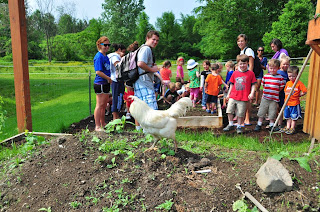Comes spring, remove the mulch from the strawberry plants when about 25 percent of the plant are producing new growth. New growth will be white or yellow in color.
Happy Gardening,
Claudia
 How is it done? Primarily the credit goes to “Archer” Dale and the crew of 15 year round maintenance staff – who cover an amazing amount of ground (much of it frozen) over the eight months between seasons. Recently Nature Dave’s son joined his father and uncle making a fourth generation of Vanslettes building our resort.
How is it done? Primarily the credit goes to “Archer” Dale and the crew of 15 year round maintenance staff – who cover an amazing amount of ground (much of it frozen) over the eight months between seasons. Recently Nature Dave’s son joined his father and uncle making a fourth generation of Vanslettes building our resort. Don't
know what to do with all the leaves in your yard? Why not bring all
your efforts of raking to a good use making your own mulch.
Don't
know what to do with all the leaves in your yard? Why not bring all
your efforts of raking to a good use making your own mulch. |
| JD (Jes Dean) as Schmeid in 2006. |
 |
| Jess Lynes as Schmitty in 2006. |
 |
| 2011 Pirates |

 Summer is here. Temperatures are rising, plenty of sunshine, and our vegetable garden is sending out its' rewards. Baskets filled with spinach, radishes, leek, Swiss chard, lettuce, and herbs have made their way into the kitchen, filling our guests dinner plates with delicious, organic produce.
Summer is here. Temperatures are rising, plenty of sunshine, and our vegetable garden is sending out its' rewards. Baskets filled with spinach, radishes, leek, Swiss chard, lettuce, and herbs have made their way into the kitchen, filling our guests dinner plates with delicious, organic produce. And then there is Otto the rooster, our first animated insecticide. Otto arrived with the beginning of our opening season of 2011, made his home in our vegetable garden, and has already been promoted to our new department head for pest control. As he is patrolling the rows of our raised beds, continuously on the move, he picks up bugs and weed seeds with nearly every peck he takes. He seems to enjoy his new territory and assignment; he loves to mingle with our young guests, and sublets his coop to a little chipmunk.
And then there is Otto the rooster, our first animated insecticide. Otto arrived with the beginning of our opening season of 2011, made his home in our vegetable garden, and has already been promoted to our new department head for pest control. As he is patrolling the rows of our raised beds, continuously on the move, he picks up bugs and weed seeds with nearly every peck he takes. He seems to enjoy his new territory and assignment; he loves to mingle with our young guests, and sublets his coop to a little chipmunk. Last spring we introduced the new raised bed gardens and this spring we have been working on a new addition: a Shiitake Mushroom farm. The Shiitake farm is located down by the hillside of the Clubhouse. Once the wood is fully colonized mushrooms will spring forth from cracks or channels in the wood.
Last spring we introduced the new raised bed gardens and this spring we have been working on a new addition: a Shiitake Mushroom farm. The Shiitake farm is located down by the hillside of the Clubhouse. Once the wood is fully colonized mushrooms will spring forth from cracks or channels in the wood. 
 Eastern and Western Europe and even packed up and moved to experience winter in another culture. There is something special about the staff that the Tyler Place attracts. Reunions are always a good time.
Eastern and Western Europe and even packed up and moved to experience winter in another culture. There is something special about the staff that the Tyler Place attracts. Reunions are always a good time.